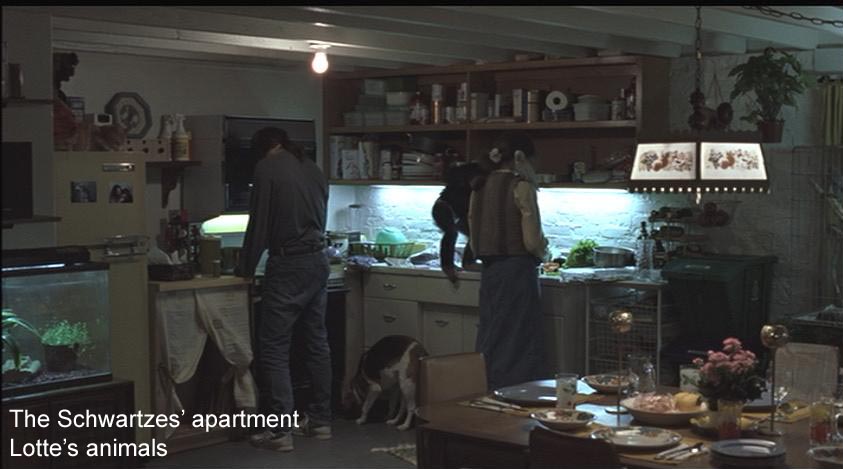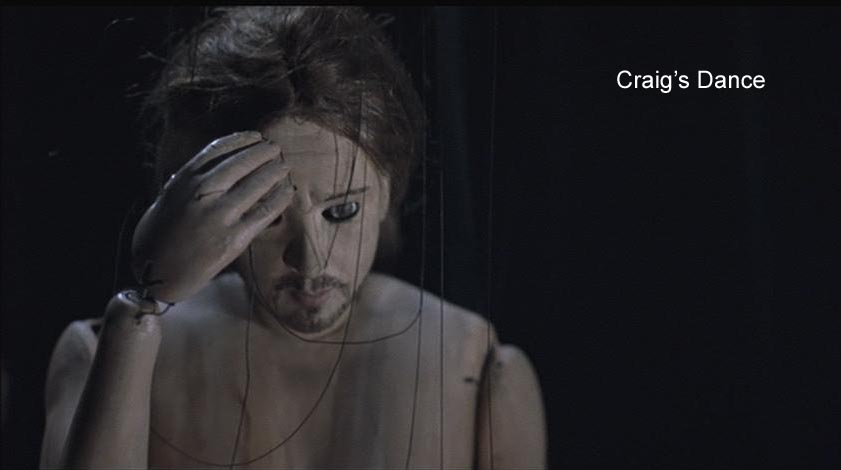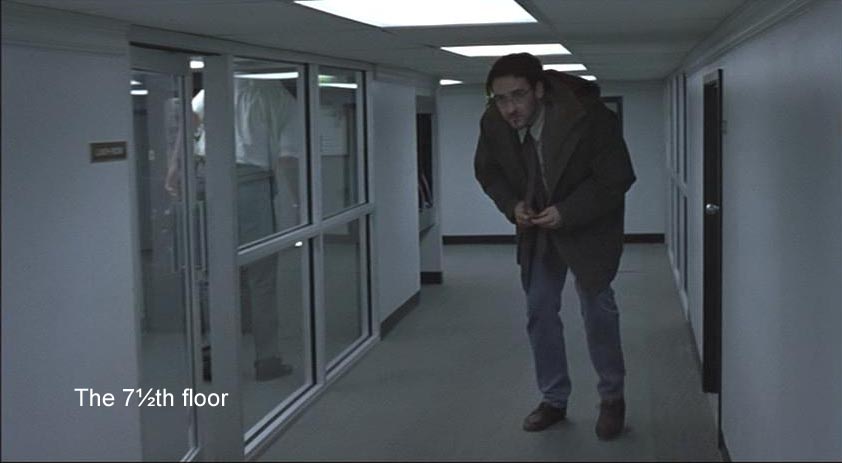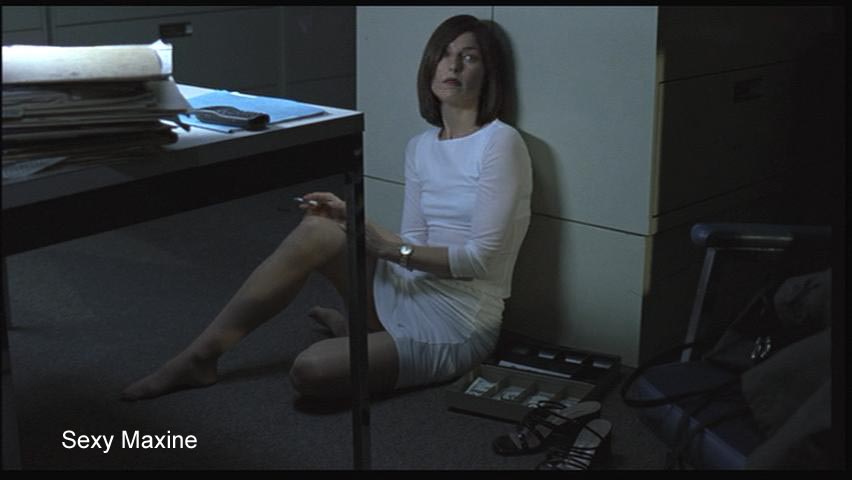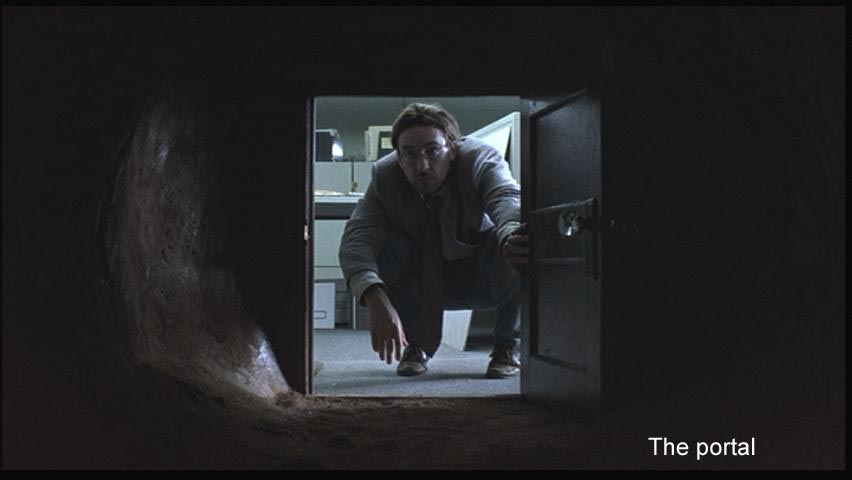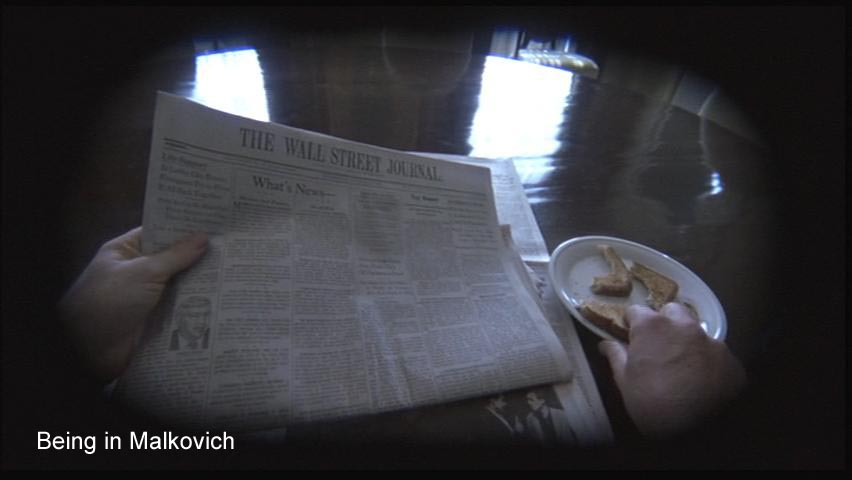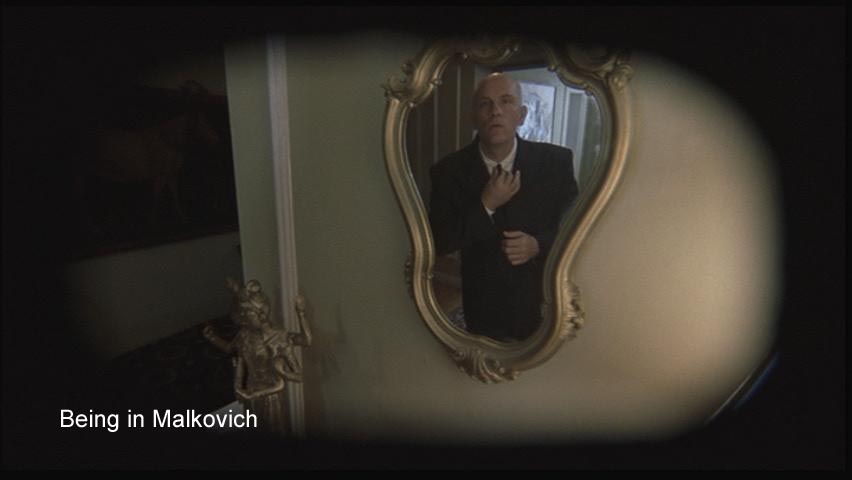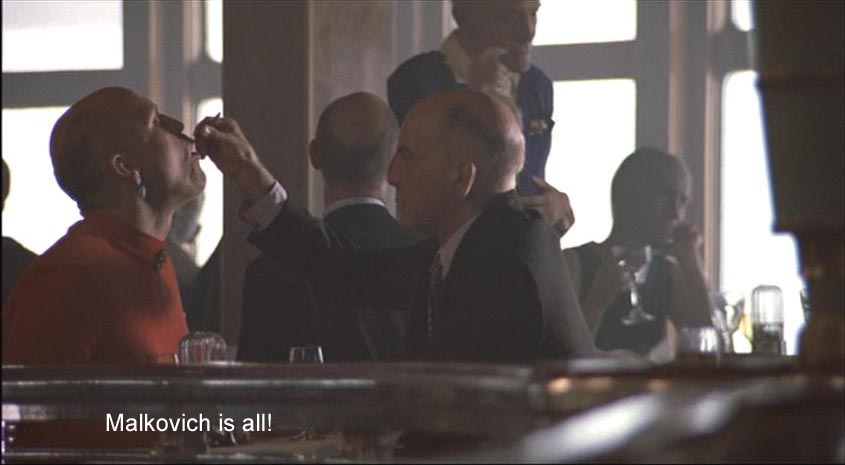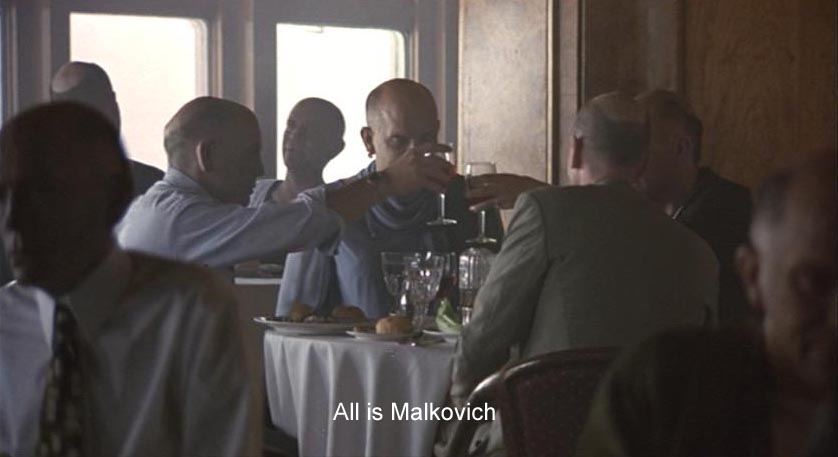I think this is a film both wacky and profound. Would you believe, there is a hole in the wall, a “portal,” a long tunnel (a birth canal?) on the 7½th floor (!) of a building and, if you crawl into it, there is suction and weird music, and you find yourself inside John Malkovich's head, seeing through his eyes and hearing through his ears. Then, after fifteen minutes, you are dumped out into a ditch alongside the New Jersey Turnpike. Give me a break!
Screenwriter Charlie Kaufman and director Spike Jonze have been insanely inventive in making this film. And they have even, I think, been profound. Yet this mix of wackiness and profundity creates a problem for critics, and not just me. I find it terribly hard to see this film as a unified work of art because it goes off in so many weird directions. That's the astonishing inventiveness of it.
For example, why Abelard and Eloise at the beginning? Why the 60-foot puppet of Emily Dickinson? Why the 7½th floor? Why the New Jersey Turnpike? Why Björk's “Amphibian” at the end? This film takes me back to the 1960s and what I then called “the puzzling movies” such as Last Year at Marienbad, Hiroshima Mon Amour, or Antonioni's baffling trilogy. Incidents happen without much attention to realistic causality, and that seeming randomness should clue us now—as then—to look for patterns of repetition and contrast that would turn the film into an artistic whole.
Kaufman and Jonze are clearly inventive, not to say wacky. As for their profundity, I think Being John Malkovich is a film about the complexity of our human nature, how we are both intensely social animals, but highly individual animals as well.
To put that another way, I think this zany film plays out a lot of our ideas of what we mean when we say we are “in” another person. The title is exact, and so is Craig (John Cusack) on puppeteering: “It's the idea of being someone else, of getting inside their skin, seeing what they see, feeling what they feel.” Actors get into their characters (as do puppeteers). We civilians say things like: We live on in our children. Our dead forebears live on in our memories. I empathize with you. I feel your pain. At the same time, we say things like: Be yourself, or, To thine own self be true. We prize individuality and the individual, particularly in America.
This film plays in the most outrageous way with the tension between these two modes of our being, the self of consciousness and our identifications with others. Incidents develop variations on these ideas one after the other with no particular rationale for the order except the rather bizarre plot. In particular, I think the ending, with the idea that you have to enter another person's brain, a “vessel,” before midnight on that person’s forty-fourth birthday, just a tad contrived, a gimmick to create a suspenseful ending, or just an ending. How did John Malkovich or Emily get to be “vessels” anyway?
I can sum up the way I see this film as three modes of one central idea, namely, being yourself or as the film terms it, being in someone else's skin. The title is exact. There are positive ways of being in someone else's skin, ways that do not change your own core identity and may enrich and enlarge it. And there are negative ways, that is, ways that do not fundamentally change your personal identity and may simply conflict with it.
Among the positive ways is the artist's way of identifying with another (and the film's opening shot is of a theatrical curtain). Here it is Malkovich's acting, his acting of Richard III, for example, or his reading of lines from Chekhov. The actor becomes a focus for other people's dreams (like the man who praises John Malkovich’s portrayal of a “retard”). By contrast, Craig's puppeteering is another form of artistic identification with another, but it seems more pathological, and so it turns out to be. Both ways open up possibilities for the two men. And both open up possibilities for us, their audience, as we experience their art. There is no loss of self but a possible gain of experience and understanding.
Sex and love are other positive ways that we enter into another—quite literally as Maxine (Catherine Keener) puts it. Lotte feels John Malkovich's sexual sensations, as does Craig. There is a mingling of ecstasies with, perhaps, some gain of experience and understanding. Lotte (Cameron Diaz) discovers that she is really male or lesbian when she experiences sex in John Malkovich's body. And through her sexual experience inside Malkovich, she creates a family with Maxine and “their” child Emily. Likewise, Maxine's pregnancy involves one person's being inside another, and that leads to Emily, a good outcome (no pun intended).
So, too, empathy is way of entering into another. Perhaps the best example is Capt. Mertin's creation of the 7½th floor as a result of his empathy with the strange “little person” who appears in his office and asks him to understand how she feels her world. Almost the whole movie stems from that empathic act, since the portal on that mysterious 7½th floor makes possible all the empathies by Craig and Lotte. We might contrast their experiences with the “customers” who take merely a 15-minute “ride” in John Malkovich. (Is this Andy Warhol's “15 minutes of fame”?) They simply experience John Malkovich's sensations, his ordering a bath mat or eating a piece of toast. The relationships with Maxine and Lotte and Craig and, above all, Dr. Lester (Orson Bean) go far beyond that.
Finally, among these positive ways of being in “someone else's skin” is immortality (as, for example, Shakespeare described it in the Sonnets): people live on in our heads. Our dead parents and other significant people live on in our memories of them, and, indeed, change our personalities because of our identification with them. So far as I know, that is my only immortality, living in the minds and personalities of my children and their children. It is the only immortality my parents have. Thus, in this film, in its very peculiar finale eight years after the first dive into the portal, the elderly (the soon to die Dr. Lester and his friends), literally live on in John Malkovich's skin. And John Malkovich at the end even looks and talks like Dr. Lester. This succession of lives in “vessels” enacts a peculiar and secular idea of immortality.
In short, these ways of being in someone else's skin combine that otherness, that externality, with an essential unchanging you. They can contribute to your personal identity, enlarging it. By contrast, the film develops a series of negative externalities that do not change or enlarge your identity.
Your name is one. Think of the mishmash that secretary Floris (Mary Kay Place) makes of Craig's name when he applies for his job at Lester Corp. When Craig mentions John Malkovich, Maxine says, “Who's he?” The taxi driver can't remember his name. In the opposite, in the film's most astonishing scene, everything and everybody is “Malkovich.” The animals have names (the chimp Elijah, the parrot Orrin Hatch[!]), but these do not change their being. Craig changes his name to John Malkovich when he makes the inhabited Malkovich a puppeteer, but that does not change Craig at all. And the Malkovich in this film is not Malkovich: he changed his middle name from the real one, Galvin, to Horatio.
Your age does not define you: look at Dr. Lester, aged 105. Neither is it true that “you are what you eat.” He is not carrot juice. You are neither what you consume nor what you have sex with nor how you have sex. You are not what you see in the mirror. Craig's “Dance of Despair and Disillusion” takes care of mirrors, twice(!). You are not what you speak. After all, the parrot (Orrin Hatch) speaks.
Neither does fame change your essential being. Twice people think John Malkovich was in some jewel thief movie. The public has no real idea even of the star side of the person. Poor beautiful Cameron Diaz, unrecognizable in this awful wig and zilch make-up, yet she is still Cameron Diaz. John Cusack too looks dreadful. Their fame as stars doesn't change that. Fame does not create or enlarge an inner identity. You can even detach fame from the person and use it, as Craig does when he makes John Malkovich a puppeteer.
Your looks don't define you. Craig is Craig even when he looks like Malkovich. Nor your environment. Everyone has to stoop to get around the 7½th floor, but no one is changed by it. Your occupation does not change you. Craig gets a job as a file clerk—no change. Sean Penn decides to become a puppeteer—no change in Sean Penn.
Gender does not define you: Lotte comes to think she is a male, but that does not change the essentially maternal Lotte.
Being godlike, being able to control another body does not change you. Craig's manipulating a Maxine puppet gets him nowhere with that redoubtable lady. And even controlling John Malkovich's body does not add to or change the essential Craig.
Strangely, your own consciousness does not seem to define you. Consciousness is a curse, Craig tells the chimp Elijah. Consciousness is suffering. In a famous essay “On the Marionette Theatre,” writer Heinrich von Kleist argued that one can achieve true grace only as a puppet or a god, that is, without self-consciousness. (To have written this movie, Kaufman must have read this essay.) And at the end, Craig-in-John Malkovich's puppet shows do achieve true grace.
When you are inside John Malkovich or some other “vessel” (like Craig in Emily), you have your own consciousness as well as John Malkovich's perceptions and the two fuse together strangely as Dr. Lester's does with John Malkovich in the finale. Dr. Lester/Malkovich is able to fulfill his desire, to live forever. Craig, however, is imprisoned in Emily and suffering, because he is passive. He cannot fulfill his desires. (Something about the forty-fourth birthday.)
What, then, is the essential you that (perhaps) becomes enlarged by being in another's body, by empathizing with another person, for example? What defines the you-ness of you in this movie? The one character who never goes into John Malkovich's body is Maxine. She never changes and never falters. Maxine is totally stable. She describes the world as made up of two types of people, those who go after the things they want and those who don't. She is the former. Maxine is simple desire.
Maxine shows that it is your desire that defines you. For her it is money and a family. Craig wants success as a puppeteer, and that never changes. He wants both Maxine and Lotte, and that too never changes; in fact, it drives the whole plot. Lotte needs to be a caretaker, a parent, first to her animals, then to Emily. After her experience in John Malkovich's body, she learns that she needs to be a male or the male half of a lesbian couple. She desires Maxine, and once that is established, it does not change. Dr. Lester wants to live on and that desire drives him through a succession of bodies.
When Malkovich goes into his own mind, everything becomes Malkovich. That is to say, his desire changes everything into what he desires, the actor's desire to be able to be anybody and everybody and everything. This, the film's most amazing scene, imitates a rare psychiatric disorder, the Fregoli syndrome, in which the sufferer believes that different people, family, friends, anybody, are in fact one person.
It is tempting to think of this movie as very postmodern, involved with all kinds of hot conceptions like the disappearing subject, the simulacrum as reality, the shifting signifier or signified, and many another jargony postmodern wonder. But, in fact, it seems to me, this film embodies a very traditional idea of human identity. Identity is desire. We have something—Descartes called it a soul; Nietzsche would call it our will; in psychological terms, I'd call it our drives—and that something simply is us. When we say “I,” that is whom we are talking about. After the wild joyride of Being John Malkovich, we come back to the one thing we ineluctably have, ourselves, no matter how old-fashioned that notion might seem. Indeed, all three of the Kaufman/Jonze films (as of 2010) begin with heroes who are dissatisfied and frustrated, who are unable to fulfill their desires, and who go into some strange fantasy world for satisfaction.
In short, the constancy of our desire defines us, but the experience of being in someone else's skin (through the arts? through empathy?) can expand and enrich that identity. To me, this idea makes as much coherence for this chaotic movie as I can make. But I feel there are still loose ends. Why Abelard and Eloise at the beginning? Why the 60-foot puppet of Emily Dickinson? Why the 7½th floor? Why the New Jersey Turnpike? Why Björk's “Amphibian” at the end with its unintelligible Icelandic(?) lyrics? Rather than try to embed answers to those questions in this essay, I've stuck them in a separate file, which is here.
